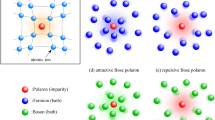Abstract
It has been shown that the relativistic effect on the electrons reveal in the heavy element region.1–3 What kind of changes will appear in the heavy elements because of the relativistic effects? Can we observe the changes? We observed that the boiling points of astatine and radon are lower than that extrapolated values from lighter elements in the same groups.4,5 We examined the systematic behavior of the elements on the boiling point and have found a new method for the estimation of the boiling points of the superheavy elements in the halogen and rare gases. The estimated values of the elements 117 and 118 are 618 and 247 K, respectively which are considerably lower than those6 obtained until now. If these values are correct the production of the superheavy elements with heavy ions reaction may be affected. Further, the chemical properties may be fairly different from the lighter elements.
Similar content being viewed by others
References
B. FRICKE, in: Structure and Bonding, J. P. DUNTIZ et al. (Eds), Springer Verlag, Berlin, 21 (1975) 89.
J.-P. DESCLAUX, At. Data Nucl. Data Table, 12 (1973) 311.
J. B. MANN, Acad. Sci. USSR. Inst. Hist. Sci. Technol., Nauka, Moscow, 1976, p. 161.
K. OTOZAI, N. TAKAHASHI, Radiochim. Acta, 31 (1982) 201.
N. TAKAHASHI, K. OTOZAI, Intern. J. Radio. Appl. Instr. Part A, Appl. Rad. and Isot., 37/3 (1986) 191.
R. C. WEAST (Ed.), Handbook of Chemistry and Physics, 78th ed., CRC Press, Inc., West Palm Beach, FL, 1998.
A. GHIORSO, H. NURMIA, J. HARTRIS, K. ESKOLA, P. ESKOLA, Phys. Rev., 22 (1971) 1317.
G. MUENZENBERG et al., Z. Phys., A317 (1984) 235.
G. MUENZENBERG et al., Phys., A333 (1989) 163.
Yu. Ts. ORGANESSIAN et al., Phys. Rev. Lett., 83 (1999) 3154.
V. NINOV et al., Phys. Rev. Lett., 83 (1999) 1104.
O. L. KELLER Jr., G. T. SEABORG, Ann. Rev. Nucl. Sci., 27 (1979) 139.
D. C. HOFFMAN, Radiochim. Acta, 72 (1996) 1.
M. SCHAEDEL et al., Nature, 388 (1997) 55.
B. WIERCZINSKI et al., Radiochim. Acta, 69 (1995) 77.
K. E. GREGORICH et al., Radiochim. Acta, 43 (1988) 22.
K. OTOZAI, Private communication, 1977.
L. PAULING, J. SHERMAN, Z. f. Krist., 81 (1932) 1.
Author information
Authors and Affiliations
Rights and permissions
About this article
Cite this article
Takahashi, N. Boiling points of the superheavy elements 117 and 118. Journal of Radioanalytical and Nuclear Chemistry 251, 299–301 (2002). https://doi.org/10.1023/A:1014880730282
Issue Date:
DOI: https://doi.org/10.1023/A:1014880730282




